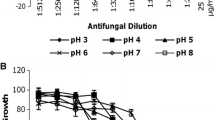Abstract
Nutritional physiological and tolerance tests were performed for all type strains of species currently classified in the black yeast generaExophiala andPhaeococcomyces, including some additional type strains of taxa recently reidentified asExophiala species. Most describedExophiala species can be distinguished by physiological characters.Exophiala jeanselmei with its varieties, andE. castellanii should all be retained as separate taxa. The pairs of strainsMycotorula schawii/Exophiala dermatitidis, Hormodendrum negronii/Exophiala jeanselmei var.lecaniicorni andSporotrichum gougerotii/Torula bergeri were found to be conspecific. Phenetic analyses of physiological data support the identity ofPhaeococcomyces exophialae as a yeast-like synanamorph ofExophiala spinifera. The taxonomic positions of the generaNadsoniella, Phaeoannellomyces andWangiella are discussed. The generaExophiala andPhaeococcomyces are unrelated.
Similar content being viewed by others
References
Barnett JA, Payne RW & Yarrow D (1990) Yeasts: characteristics and identification, 2nd ed. Cambridge Univ. Press, 1002 pp
Bulanov PA & Malama AA (1965a) Charakteristika odnogo iz gribov rodaPullularia. Vesci Akad. Navuk Belaruss. SSR. 4: 116–117
—— (1965b) Vliyanie polisakharida iz ‘chemikh drozhenyi’ na rost opukholi Ehrlicha. Doklad. Akad. Nauk Belarus. 9: 270–272
Carmichael JW (1966) Cerebral mycetoma of trout due to aPhialophora-like fungus. Sabouraudia 5: 120–123
Espinel-Ingroff A, McGinnis MR, Pincus DH, Goldson PR & Kerkering TM (1989) Evaluation of the API 20C yeast identification system for the differentiation of some dematiaceous fungi. J. Clin. Microbiol. 27: 2565–2569
Goto S, Aono R, Sugiyama J & Horikoshi K (1981)Exophiala alcalophila, a new black, yeast-like hyphomycete with an accompanyingPhaeococcomyces alcalophilus morph, and its physiological characteristics. Trans. Mycol. Soc. Jap. 22: 429–439
Haase, G, Sonntag L, Peer Y van de, Uijthof JMJ, Podbielski A & Melzer-Krick B (1995) Phylogenetic analysis of ten black yeast species using nuclear small subunit rRNA gene sequences. Antonie van Leeuwenhoek 68: 19–33, this issue
Hironaga M, Watanabe S, Nishimura K & Miyaji M (1981) Annellated conidiogenous cells inExophiala dermatitidis, agent of phaeohyphomycosis. Mycologia 73: 1181–1183
Hoog GS de (1977)Rhinocladiella and allied genera. Stud. Mycol. 15: 1–140
-- (1983) On the potentially pathogenic dematiaceous hyphomycetes. In: Howard DH (Ed) The Fungi Pathogenic for Humans and Animals B2 (pp 149–216)
Hoog GS de & Gerrits van den Ende AHG (1992) Nutritional pattern and eco-physiology ofHortaea werneckii agent of human tinea nigra. Antonie van Leeuwenhoek 62: 321–329
Hoog GS de, Guého E, Masclaux F, Gerrits van den Ende AHG, Kwon-Chung KJ & McGinnis MR (1995) Nutritional physiology and taxonomy of human-pathogenicCladosporium (Xylohypha) species. J. Med. Vet. Mycol. 32: 373–380
Hoog GS de & Haase G (1993) Nutritional physiology and selective isolation ofExophiala dermatitidis. Antonie van Leeuwenhoek 64: 17–26
Hoog GS de, Marvin-Sikkema FD, Lahpoor GA, Gottschall JC, Prins RA & Guého E (1994a) Ecology and physiology of the emerging opportunistic fungiPseudallescheria boydii andScedosporium prolificans. Mycoses 37: 71–78
Hoog GS de, Matsumoto T, Masuda T & Uijthof JMJ (1994b)Exophiala jeanselmei var.lecanii-corni, an etiologic agent of human phaeohyphomycosis, with report of a case. J. Med. Vet. Mycol. 32: 373–380
Hoog GS de, Takeo K, Yoshida S, Göttlich E, Nishimura K & Miyaji M (1994c) Pleoanamorphic life cycle ofExophiala (Wangiella) dermatitidis. Antonie van Leeuwenhoek 65: 143–153
Hoog GS de & Yurlova NA (1994) Conidiogenesis, nutritional physiology and taxonomy ofAureobasidium andHormonema. Antonie van Leeuwenhoek 65: 41–54
Issatchenko BL (1914) O rozovykh i chernykh proffach. Ann. Exped. Sci. Indust. Mourmansk pp 264–275
—— (1934)Nadsoniella nigra Iss. Mykrobiol. Zh. 1: 75–82
Iwatsu T, Udagawa S-I & Takase T (1991) A new species ofExophiala recovered from drinking water. Mycotaxon 41: 321–328
Kane J & Summerbell RC (1987) Sodium chloride as an aid in identification ofPhaeoannellomyces werneckii and other medically important dematiaceous fungi. J. Clin. Microbiol. 25: 944–946
Katz B & McGinnis MR (1980) A new species ofExophiala recovered from loblolly pine litter. Mycotaxon 11: 182–184
Lyakh SP & Ruban EL (1970) Antarctic ‘black yeasts’Nadsoniella nigra var.hesuelica (characteristics and identification of strain 365). Izv. Akad. Nauk SSSR 4: 581–592
Maddison WP & Maddison DR (1992) MacClade Analysis of Phylogeny and Character Evolution, version 3, Sinauer, Sunderland
Masclaux F, Guého E, Hoog GS de & Christen R (1995) Phylogenetic relationships of human-pathogenicCladosporium (Xylohypha) species inferred from partial LS rRNA sequences. J. Med. Vet. Mycol. (in press)
Matsumoto T, Padhye AA, Ajello L & McGinnis MR (1986)Sarcinomyces phaeomuriformis: a new dematiaceous hyphomycete. J. Med. Vet. Mycol. 24: 395–400
McGinnis MR (1977)Wangiella, a new genus to accommodateHormiscium dermatitidis. Mycotaxon 5: 353–363
McGinnis MR & Ajello L (1982) A note onSporotrichum gougerotii Matruchot 1910. Mycotaxon 16: 232–238
McGinnis MR & Padhye AA (1977)Exophiala jeanselmei, a new combination forPhialophora jeanselmei. Mycotaxon 5: 341–352
McGinnis MR, Schell WA & Carson J (1985)Phaeoannellomyces and the Phaeococcomycetaceae, new dematiaceous blastomycete taxa. Sabouraudia 23: 179–188
Pedersen OA & Langvad F (1989)Exophiala psychrophila sp. nov., a pathogenic species of the black yeasts isolated from farmed Atlantic salmon. Mycol. Res. 92: 153–156
Sneath PH & Sokal RR (1973) Numerical Taxonomy. Freeman, San Francisco
Steadham JE, Geis PA & Simmank JL (1986) Use of carbohydrate and nitrate assimilation in the identification of dematiaceous fungi. Diagn. Microbiol. Infect. Dis. 5: 71–75
Swofford DL (1990) PAUP: phylogenetic analysis using parsimony, version 3.1.1. Illinois Natural History Survey, Champaign, Illinois
Uijthof JMJ & Hoog GS de (1995) PCR-ribotyping of type isolates of currently acceptedExophiala andPhaeococcomyces species. Antonie van Leeuwenhoek 68: 35–42, this issue
Uijthof JMJ, Belkum A van, Hoog GS de & Haase G (1995) A DNA hybridization probe specific to the human-pathogenic black yeastsExophiala dermatitidis. J. Med. Vet. Mycol. (in press)
Walt JP van der & Yarrow D (1984) Methods for the isolation, maintenance, classification and identification of yeasts. In: Kreger-van Rij NJW (Ed) The Yeasts, a Taxonomic Study. 4th ed. (pp 45–104) Elsevier, Amsterdam
Author information
Authors and Affiliations
Rights and permissions
About this article
Cite this article
de Hoog, G.S., Gerrits van den Ende, A.H.G., Uijthof, J.M.J. et al. Nutritional physiology of type isolates of currently accepted species ofExophiala andPhaeococcomyces . Antonie van Leeuwenhoek 68, 43–49 (1995). https://doi.org/10.1007/BF00873291
Issue Date:
DOI: https://doi.org/10.1007/BF00873291




